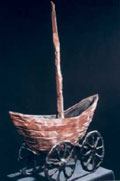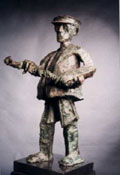Oriental Occidental
Exhibition of Bronze Sculptures and Drawings
by John Behan RHA
May 22nd - Jun 11th 1998
Official Opening by Seamus Heaney
|
#1 Drag |
#2 Junk |
#3 Chinese Warrior |
|
#4 Ancient Ship (Cyprus) |
#5 Rabbi |
#6 Lotís Wife |
|
#7 Ark |
#8 Trojan Horse |
#9 Camel |
|
#10 Potatoes/Famine |
#11 Clare Island Fisher |
#12 McGinty's Goat |
|
#13 Broighter Boat |
#14 Newgrange Boat |
#15 Ostfold Boat |
|
#16 Telemark Boat |
#17 Middle East |
#18 Ghostboat I |
|
#19 Ghostboat II |
#20 Sculptor's Hand |
#21 Boar of Benbulben |
|
#22 Ghostboat III |
#23 Poet's Tree |
#24 Tree of Life |
|
#25 Liberty Tree |
#27 Daisy the Cow |
|
|
#29 Fish |
#30 Famine Cart |
|
|
#31 Children of Lir |
#32 Fish Relief I |
#33 Fish Relief II |
|
#34 Oedipus Rex |
#35 Bloom |
#36 Pier |
|
#37 Egyptian Woman |
#38 Ikarus |
#39 Ikarus Falling |
|
#40 Ghostboat IV |
|
#41 Daisy |
#42 Bull I |
#43 McGinty's Goat |
|
#44 Montydog |
#45 Bull II |
#46 Bofin Cock |
Speech delivered by Seamus Heaney on the occasion of the official opening of "Oriental Occidental" by John Behan - May 22nd 1998.
It is a pleasure as ever to come back to Galway, to be among friends and to have the opportunity to associate myself with the strong art and sturdy soul of the sculptor John Behan. It is also a happy coincidence that this exhibition should be opening so close to the eightieth birthday of Maureen, mother of all the Kennys: It gives us another opportunity to celebrate her achievements as the Madonna of the bookmen - Tom, Des, Connor and as the guardian to the holy door to her land of books. Her welcome has been constant and important for all the writers and readers who ever visited this legendary bookshop. It is another happy coincidence that Kenny's Art Gallery should lead directly into their bookshop, because this architectural closeness is a good image of how John Behan's creative mind is structured. Inside his sculptor's head there is a room which is kind of a studio-gallery, where he sees and works at the shapes of his art: but beside this work room, there is the back room where he does his reading and enjoys those reveries on the great heroes of Irish Literature and Mythology from which so much of his work proceeds.
I want to begin, however, by talking about tapestry rather than sculpture - which may seen odd but it will all make sense in a moment. The tapestry I have in mind is a metaphorical one, even a mysterious one, and the one that W.B. Yeats talked about at the end of his life. "Behind all Irish History" Yeats wrote in 1937, "hangs a great tapestry." In Yeat's imagination, the ancient heroes of myth and legend move in this tapestry beside the famous figures of historical times, past and present. As he says later on in the essay, "Parnell, Swift, Lord Edward, have stepped back into the tapestry." And so now Has Yeats himself. He has become a name. Mention that name and the whole harp of Irish cultural memory trembles. The wind among the reeds blows across the tapestry itself.
To become a name, not in the People Magazine sense but in this more archetypal way, is the greatest destiny that an artist can achieve. In this context, of course, the important thing is that the name denotes not the biography, not the celebrity, but the work. Not the poet or the painter as a person but the poet's or the painter's vision. Say the name of Dante and you think of the circles of hell or the brilliant light-filled visionary palette of his late paintings or the characteristic drama of his early woodcuts. Say the name John Behan and you see the bulls of Cooley and the Children of Lir and the bittern of Cathal Bui, and the birds of Aengus, and now, after the this exhibition, the boats of Broighter and the Ostfold boat and the ghost boat and even the boar of Ben Bulben. My point is that John Behan has made a mark in our collective imagination, that his work for many of us represents different stages of our life to us, that by now its simply part of our mental furniture. Mind you, it was probably a hard enough fated to begin as an artist in Ireland in the nineteen sixties with a name like Behan. I am reminded of a story Tom Flanagan told me once about a conversation between the novelist Isaac Bashevis Singer and his granddaughter. Singer lived in an apartment on the West Side of New York and the granddaughter lived in California on the West Side of the continent. Singer had just won the Nobel Prize for a lifetime's achievement in fiction, the granddaughter had just written but not yet published her first novel, and she was ringing her grandfather to announce the good news to him. "Great, great, my dear", said the old man, "and when you publish, what name will you use?" "I thought I would not use my married name", the young woman replied, "but my family name, Singer". "Oh now, I'm not sure about that," the grandfather replied, "one Singer at a time, I think that is the rule".
The Behan rule, of course, even in Brendan's family was never one Behan at a time, and as an artist in a different medium John must have had a problem of definition and a certain amount of what we might call separation anxiety. But the point is that in spite of all the glamour and turmoil that was occurring in another corner of the tapestry reserved for the most spectacularly dramatic section of the Behan party, John the sculptor did manage to define a separate area for himself and was able to exhibit his own characteristic strength's, take possession of his own artistic ground and make that mark in the collective mind that I have spoken of already.
I met John when he and I were members of the Arts Council in the early nineteen seventies. I had recently resigned from my job in Queen's University and was then living and working as a freelance writer in Co. Wicklow. It was and intense and important time in all our lives; we has a sense of being at risk, a sense of having sacrificed some security for the sake of vocation; and we also realised that our families had been asked to live in slightly more reduced circumstance than they might have enjoyed had we gone in for the accountancy, say, instead of the artistic side of things. I loved the spirit of adventure and commitment and the air of inner freedom that came from John in those days; it gave you and intimation of solidarity. His values were so sure, his ironical attitude to merely economic success was confirming and reassuring, his sense of justice and his identification with the have-nots of the world unsanctimonious and exemplary.
With John Behan, there is no game playing, no artsy role playing, no temperamental swank or masquerade. You meet the man, not he mask, the inner soul rather that the social exterior. There is something psychologically salubrious about him; it as if you are encountering what the Upanishads calls "the ancient self", something previous to and underlying individual character, some kind of psychic bedrock. And the theme and motifs of this exhibition are, of course, consonant with that impression which John makes as a person. Here his artistic preoccupation is with the archetypal images, with the primal ways of figuring the experience of life and death. The metaphor of the journey, the image of the boat and the tree, the image of the warrior and Trojan horse, these do not belong simply and singularly to the individual mind but are possessions of the species. John is following the journey of the soul, its tests and its triumphs; he is tracing the path of the one whom Joseph Campbell called "the hero with a thousand faces", and the hero who appears under so many different guises, as Oisin or Aenas or Odysseus or Everyman or St. Brendan the Navigator or Colmcille or the Ancient Mariner. The traveller going from east to west, Icarus rising and Icarus falling, the sailor setting forth on the ocean, these figures are primary ones in the human imagination.
In this exhibition, for example, John Behan's images of Nordic boats and Chinese warriors, of Icarus and the Children of Lir are all aspects of his preoccupation with the ancient motif. These sculptures please us by their materiality, by their substantial physical presence, their bronze in-placeness, their this-worldness. For they are not in the least otherworldly. They are produced by somebody who knows the trade of metal work, who would be at home labouring in a foundry, who knows the behaviour of bronze as it was known in the workshops of Rodin and Michelangelo. And yet in spite of the down-to-earthiness and this-worldness of these images John has made, there is also present in them and behind them a sense that they are vessels of spirit, symbols of human knowledge, images, as Yeats said," that yet/ fresh images beget".
Seamus Heaney
Please note: Art displayed for past exhibitions may no longer be available. Please click on the "Art Currently Available By This Artist" button to view all our current holdings by this artist.
Alternatively, our mailing list will notify you of new works and exhibitions for all artists you express an interest in.

